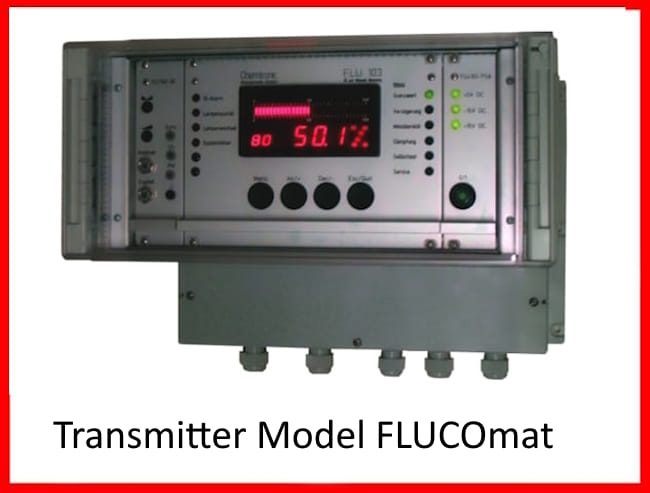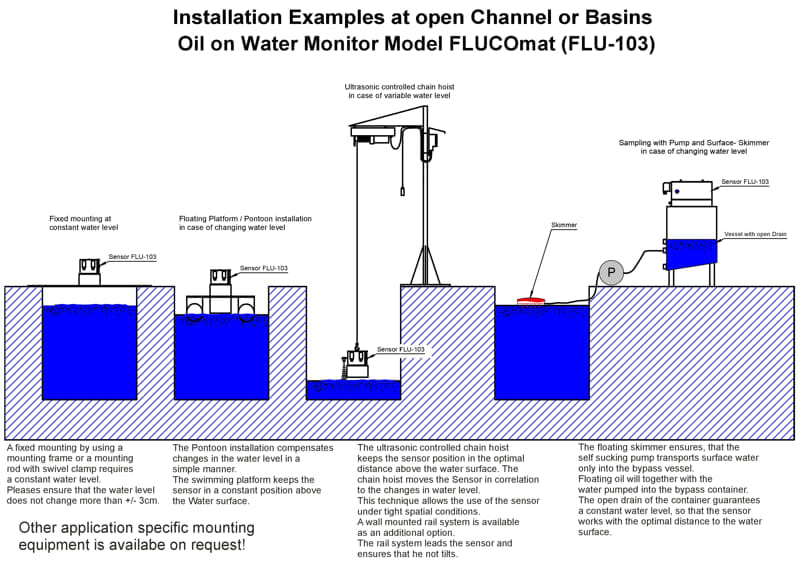Oil on Water Monitoring with Model FLUCOmat
Description:
Oil on water monitoring with model FLUCOmat:
The device is used for continuous monitoring of water surfaces.
It detects floating oil films with extreme high sensitivity.
UV- Stimulated Fluorescence principle:
- Organic substances such as fats and oils are fluorescent. When they are irradiated with UV light , they begin to glow.
- Electronically excited molecules release energy and return to their ground state.
- This process is known as fluorescence.
- The emitted radiation has a longer wavelength than the radiation used for excitation.
Application:
- The FLUCOmat system is used to check that water is free of oil.
- It enables the early detection of oil ingress and leaks.
- The aim is to prevent environmental and system damage.
Special features:
- The sensitivity of the system is further increased by the detection of a reflection component of the UV light in addition to the fluorescence.
- The fluorescence of oils and greases can also be enhanced by tracers and made more visible in color.
Mounting:
- The sensor must be at a constant distance from the water surface.
- Fluctuations in the water level are compensated for using floats or an ultrasonically controlled chain hoist.
- To realize flow measurements, surface water is pumped into a bypass tank via a skimmer .
- The free outlet of the tank ensures a constant water level so that the measurement takes place under ideal conditions.


Detection of oils:
- The device can detect both mineral oils and synthetic oils.
Emulsion detection: - It is able to identify emulsions and free hydrocarbons.
Non-contact measurement: - The measurement method is non-contact and has a high response sensitivity.
Factory calibration: - The device is factory calibrated and ready for use.
Large scanning surface: - The scanning surface is approximately 20 cm in diameter.
Long-term stability and low maintenance: - It offers high long-term stability and requires little maintenance.
No moving parts: - The device has no mechanical wearing parts.
Long-life UV lamps or UV LEDs: - The service life of the UV lamps or UV LEDs is extremely long.
Calibration standard included: - A transfer standard is included, so no oil is required for calibration.
Automatic self-diagnosis: - The device performs a permanent automated self-diagnosis.
- The device can detect both mineral oils and synthetic oils.

Fixed mounting
Fixed mounting is an uncomplicated method of installing the sensor. It is installed using either a mounting frame or an articulated arm. Here it is crucial to ensure a constant water level. For optimum measurement results, the water level should not fluctuate by more than +/- 4 cm.
Pontoon mounting
Pontoon mounting offers a simple way of compensating for changes in the water level. The floats always position the sensor at a constant distance above the water surface. This system ensures reliable measurement regardless of fluctuations in the water level.
Tracking via chain hoist
The ultrasonically controlled chain ho ist raises or lowers the sensor to ensure a constant distance to the water surface. This is particularly useful when the sensor is used in confined spaces.
In addition to the chain hoist, the sensor is guided by a mechanical rail system. These guide rails are mounted on the shaft wall to prevent the sensor from tilting.
Bypass tank Installation
Mounting the sensor on the bypass tank. A skimmer floats on the water surface and ensures that the self-priming pump pumps the surface water efficiently. Any floating oil is fed into the bypass tank together with the water. The free outlet of the tank ensures a constant water level so that the sensor is always at the optimum distance from the water surface.

